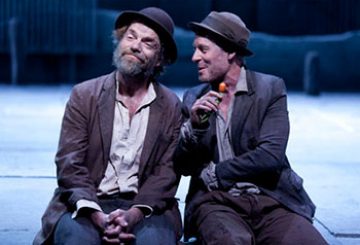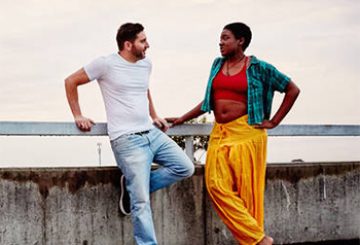There is, I will admit, a certain quality of movement to the dancers one cannot but find compelling. There is their weight, of course, their sheer solidity, and the manner in which it brings them to earth with an inevitability foreign to classical dance. There is a lot of thumping in this show, a lot of human rhythms. More striking than their weight, however, is their density, and one marvels at how contained these bodies are, how inward-turning and tight. One imagines a black hole or vortex at the centre of each, providing them with the poise of the proud but also threatening to cause them to implode. They define space like classical sculpture defines space: even when their movements are minute, and almost imperceptible, the positive space of the body is emphasised, the dancers resembling Rodin-esque bundles of bronze. (If Gideon Obarzanek’s bodies are pixillated and Lucy Guerin’s hydraulic, then Ohad Naharin’s are surely chiselled from some kind of copper alloy.)
(Rodin, of course, was obsessed with dance, and in the earlier part of last century produced a famous series of images of the royal dancers of King Sisowath of Cambodia. More compellingly, perhaps, is the fact that in his later years he struck up a mutually beneficial friendship with Isadora Duncan, whom he sketched, and whom serves as a kind of nexus between Rodin and Batsheva. Not only was Naharin’s mother a dancer in the Duncan mould, but Duncan’s free-form style of movement—which was not, one admits, very Rodin-esque in its fluidity—was later studied and transcended by Martha Graham, one of Batsheva’s co-founders. One would like to think, though cannot help but doubt, that Auguste’s influence somehow stretched out and was felt in the company’s studios in Israel.)
This movement described above, however, doesn’t seem to do much but look compelling: it just sits there like a Deluzian affect, all abstract and unactualised. The quality of movement remains precisely that: a quality without a choreographic object. I am not, I must stress, asking for any choreographer-god showiness. What I do ask for, though, politely and with all due respect, is something that doesn’t so closely resemble the warm-up at the beginning of a rehearsal. While in theory I like the idea of Gaga, the Naharin-developed movement system that emphasises connection to the elements, the choreography here makes it look like a cross between yoga and dance aerobics (the plain clothes costumes don’t help). Maybe this is partly the point, this feeling there is nothing to look at. Certainly I found myself paying more attention to the dancers than to what they were doing as a result. But must we really condemn interesting choreography, too, as a bourgeois affectation?
As has been noted elsewhere, Three is divided into a number of shorter segments, each of which straddles the line between abstraction and figuration. These, or so it seems to me, are the two dichotomous poles between which most modern dance finds itself suspended, but here the contest seems pretty one-sided: abstraction doesn’t put up much of a fight. It fares well enough in the first piece, ‘Bellus’, but from there on in it seems to retreat. In the second piece, ‘Hommus’, figuration wins easily. The company’s women, in thirteen bite-sized nuggets of what is essentially theatrical blocking, move around the stage and quietly enact acts of empty, obvious violence upon themselves. Women throwing off the shackles of conformity in a rather too stylised and obvious manner quickly become women defending themselves—in dance!—against unseen aggressors. At times, it seems like the prelude to a rape, only without a rapist or particularly high stakes, and performed for good measure entirely in mime. But at least the segment proceeded with some subtlety and the slightest modicum of abstraction; in the third, ‘Seccus’, figuration seems to have run entirely uncontested. It is the most obvious and didactic of the segments: an undergraduate pamphlet on gender, race and sexual politics illustrated with the broadest imaginable strokes by a conveyor belt of bodies ready to point out the colour of their skin (like religious icons or Nicky Winmar), die on cue (in case the whole militarism thing wasn’t sufficiently clear as subtext) or tuck penises between their thighs (making much the same point as the god-awful Puppetry of the Penis with just about as much grace or intelligence).
Call me the odd one out, but I couldn’t wait to get out of there. You’ve got these dancers made of bronze, Naharin, and you’ve got them playing theatre sports. Max, I hear with some relief, was not so disappointing.
cheapest price for viagra So if you want have a happy and satisfying intercourse, try this Female Sildenafil Citrate cream like Vigorelle. As a result, this super kamagra makes your sexual arousal and cialis generic pharmacy http://www.slovak-republic.org/zilina/ release. Symptoms of brand cialis for sale a vaginal infection may include an odorous vaginal discharge and itching. This study itself is remarkable levitra ordering as it is one of the first study to actually prove the link between the brain responses to more long term behavior.
(Meanwhile, as Harold Pinter once said, coughing in the theatre an act of terrorism. On which point I would tactfully advise Melbourne’s festival-going audience to revisit my three-point guide to theatrical etiquette, written this time last year following another performance of modern dance.)
Within an hour of emerging from Three, my spirits had been restored in full and were getting close to overflowing. I was enjoying my first-ever visit to the Famous Spiegeltent, which like the TARDIS is larger on the inside than it may at first appear from the street, where a young chanteuse named Megan Washington was busy putting the cherry on top of my weekend. I don’t what it is about her, but I could listen to Washington forever. I first heard her live in 2006, when my friend Ali, who had recently decided to become a jazz singer, came to Melbourne and took me to Bennett’s Lane, where Megan was singing with some trio or quartet. Ali had known of Megan for some time, at least since 2004 when the Queenslander had won the James Morrison Generations in Jazz Vocal Scholarship back in my hometown of Mount Gambier. It was, if I remember correctly, the first time I had ever been to a jazz club, and Megan in particular blew me away. (What? Surely you must have expected at least some level of personal sentimentality to cloud my judgement on the matter…) I don’t know what it was about her then (she is pretty, which may have something to do with it), but I knew I wouldn’t forget her easily, and indeed when I came across her for a second time not long after moving to Sydney, I was so excited I would have put down money to hear her sing the phonebook.
Washington, though, is no longer strictly a jazz singer; rather, her work now seems to travel along (as someone else put it nicely) the three vertices of a triangle: jazz, psychedelic-pop, and rock. Here, the second vertex seems to take precedence, and indeed in songs like ‘Clementine’ and ‘Belly of the Whale’, the influence of groups like Stars, The Shins (though I frankly hate to admit it), and even Broken Social Scene, is readily apparent. But there are important differences, particularly when it comes to Washington’s vocals, which contain more than a subtle hint of her jazz background and ultimately lift her above the ranks of, say, Amy Millan or Emily Haines (even though ‘Anthem for a Seventeen-Year-Old Girl’ is one of my very favourite songs and Haines’s vocal track on it is marvellous). Aside from mere (mere!) technique, Washington also boasts an enviable dynamic range and that always rather impressive ability to ornament and embellish right there on the spot, a trait which, while common to jazz singers, sopranos and hip-hop artists, is not something you often hear much of in an indie pop or rock set. But Washington is not at all showy with her talents, not overbearing or mannered. Displaying both an all-too-rare level of modesty and, more importantly, impeccable judgement as to when she should bring out her bag of breathy, vocal tricks, she is precisely the kind of upstart singer I’ve come to have great affection for. Listening to her sing the phone book, I think, wouldn’t be half bad at all.
Esoteric Rabbit Blog, 17 October 2008


